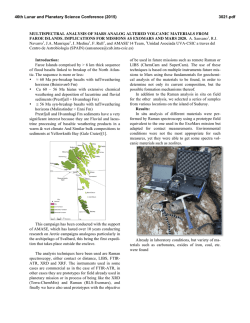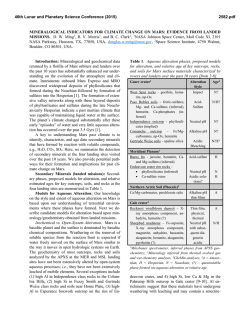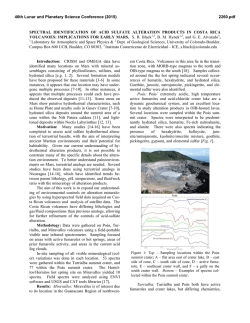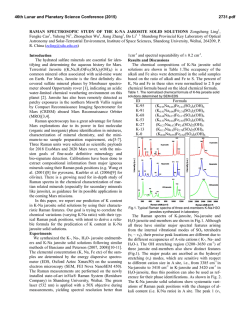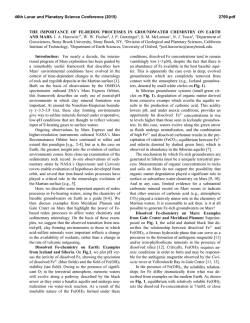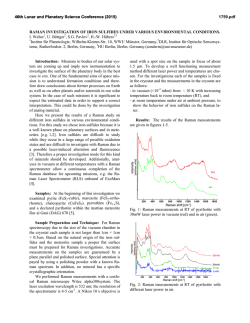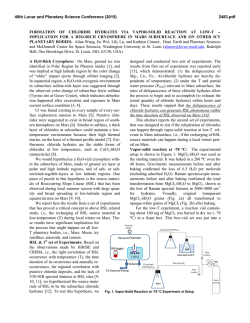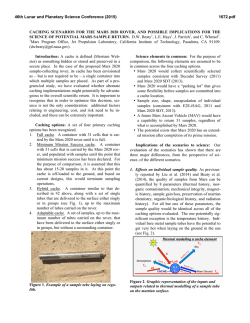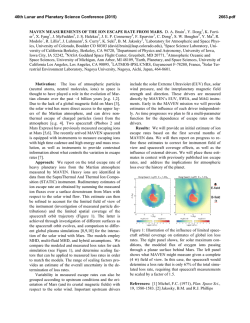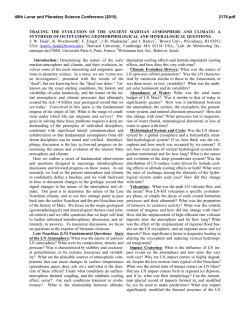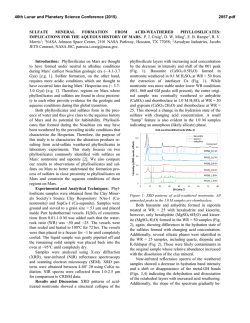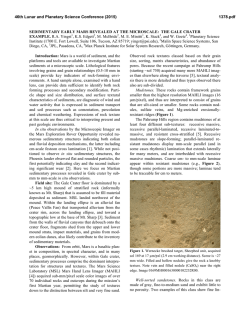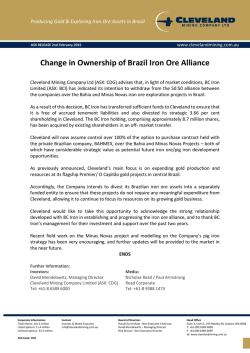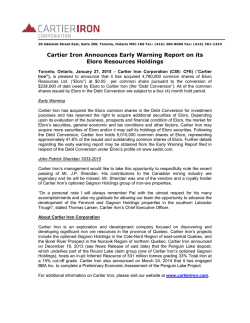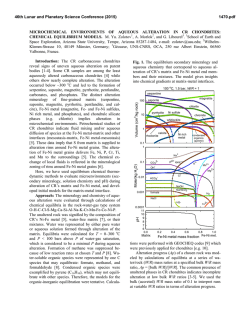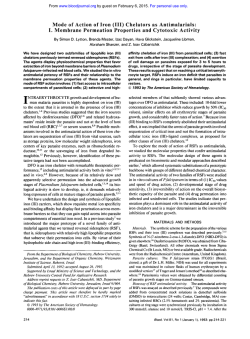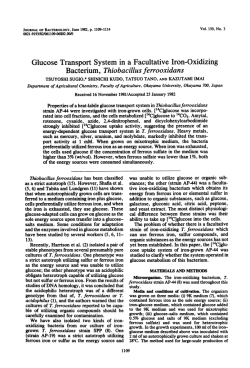
INVESTIGATING ACID SULFATE ALTERATION PROCESSES IN
46th Lunar and Planetary Science Conference (2015) 2129.pdf INVESTIGATING ACID SULFATE ALTERATION PROCESSES IN COSTA RICA AS TERRESTRIAL ANALOGS FOR EARLY MARS. L. G. Beckerman1, B. M. Hynek1,2, and G. E. Alvarado3, 1Dept. of Geological Sciences, University of Colorado-Boulder ([email protected]), 2Laboratory for Atmospheric and Space Physics, 3Instituto Costarricense de Electricidad – ICE. Introduction: Orbiters have identified abundant sulfate deposits across the Martian surface, the presence of which has been confirmed with in situ observations by landers and rovers. For example, Spirit identified sulfite-rich soils at Gusev Crater that have been attributed to acid sulfate alteration in a hydrothermal, fumarolic system [e.g. 1]. Constraining mineral assemblages formed from acid sulfate alteration processes is crucial to aiding interpretations of similar assemblages on Mars. Different water/rock ratios, pH, temperature, rock composition, and other environmental parameters affect the pathways by which alteration occurs, and produce varied end products. By characterizing the mineral assemblage formed via a specific pathway, similar mineral assemblages on Mars can be attributed to specific processes. Motivation: The presence of jarosite on Mars dramatically constricts the range of possible environmental conditions at those locales, if produced abiotically. Alternatively, jarosite could be evidence for sulfuroxidizing microbes if aqueous conditions persisted post-deposition [e.g. 2]. Recent work, however, suggests that some or all of the jarosite identified on Mars may actually be ironrich natroalunite [3-5]. Alunite and jarosite are endmembers of a mineral group with idealized formulae of AB3(SO4)2(OH)6, where jarosite has K+ in its A site and Fe3+ in its B site while natroalunite has Na+ in its A site and Al3+ in its B site. Although previous research suggested that minerals do not naturally form between the end-members of jarosite and alunite [e.g. 6], McCollom et al. [4] found natroalunite at several Nicaraguan volcanoes displaying Fe substitution for Al in the B site. This discovery resulted in the following questions that this work aims to address: (1) Is Fe-rich natroalunite a common alteration product in hydrothermal, acid fog systems? (2) What causes iron substitution in natroalunite? (3) What implications does iron substitution have for understanding early Martian surface processes? Alteration Mineralogy: To address these questions, we analyzed mineral assemblages from terrestrial analogs to early Mars at Poás and Turrialba volcanoes in Costa Rica. Basalt produced from recent eruptions at both sites is similar in composition to that of sites on Mars [7]. Minerals were analyzed using a portable Terra x-ray diffraction (XRD) instrument analogous to CheMin on Curiosity, a Bruker D2 Phaser XRD, and Raman spectroscopy. Poás and Turrialba volcanoes in Costa Rica display similar acid sulfate alteration products to those from Nicaraguan volcanoes [8]. Major alteration minerals across different settings at Poás and Turrialba include cristobalite, natroalunite, amorphous silica, both gypsum and anhydrite, and elemental sulfur (Figure 1). Figure 1 : XRD diffractograms for two samples from a gully on Turrialba at ~100°C showing major alteration minerals with representative photos from the site. na – natroalunite, s – sulfur, am – amorphous silica, g – gypsum. Iron Substitution in Natroalunite: Concentrations of iron in natroalunite grains were determined with a scanning eletron microscope (SEM) equipped with an EDS detector and an electron microbe (EMP). Natroalunite grains across different settings at Poás and Turrialba contain varying concentrations of iron in their B site and display no clear trend for environmental parameters that could be causing iron substitution. Grains from the same cm-scale hand sample show significant variation in extent of iron substutition, suggesting that highly localized processes may be responsible for sequestration of iron in natroalunite (Table 1, Figure 2). In some samples, iron is present as iron oxide patches and spherules rather than in natroalunite (Figure 3). Evaluation of Methodology: Capturing mineral assemblages on Mars requires effective detection tools on rovers and accurate interpretation of their data. Ra- 46th Lunar and Planetary Science Conference (2015) man spectrometers are relatively new on rovers and Curiosity is the first rover equipped with an XRD. Studying the efficacy of these methods and others that could be used in future missions will improve geochemical interpretations on Mars. Sample N Fe# Std. Dev. Ttop6_1 3 7.82 1.49 Table 1: Four different grains (1,4,5 and 7) Ttop6_4 3 3.38 0.42 from the same Ttop6_5 3 1.92 0.19 hand sample (Ttop6) from a Ttop6_7 5 17.1 2.03 gully on Turrialba at ~100°C display a wide range of iron substitution. N = number of analyses with EMP, Fe# = [Fe]/([Fe]+[Al]) x 100 with [Fe] and [Al] in atomic wt%. Figure 2: (left) Natroalunite grain from Ttop6 with average Fe# of 11.8. Iron is evenly distributed throughout the grain, unlike in Figure 3. Figure 3: (below) Natroalunite grain covered with iron oxide spherules, reflecting continued acid sulfate alteration. XRD: Terra XRD effectively captures major mineralogy of crystalline samples, including clays, and serves as an effective analog for CheMin [9], but misses many minor and trace elements that can be identified with a benchtop XRD. Although some shifting of natroalunite peaks due to iron substitution occurs [5], Fe# cannot be effectively calculated with XRD data. XRD also cannot identify all amorphous material when used independently. As significant portions of the Martian crust have undergone weathering to form amor- 2129.pdf phous material [e.g. 10,11], this is a key challenge for understanding mineral assemblages on Mars via XRD. Raman: While Raman spectroscopy can be used on a bulk sample to obtain overall mineralogy, Raman can also be used to map mineralogy across a sub-mm region in a thin section. Shifts in peak locations due to iron substitution are more clearly visible in Raman than in XRD diffraction patterns, but like XRD, Raman cannot identify amorphous or poorly ordered material. Remote Raman spectroscopy combined with LIBS is already in use on Curiosity, and Raman spectroscopy is planned for both ExoMars and the 2020 rover, although all have, or will have, Raman for bulk mineral analyses only. SEM: Energy dispersive spectroscopy (EDS) coupled to SEM can enable direct imaging of natroalunites at sub-micron scales, including spatial relations between Fe-rich and traditional natroalunites and the distribution of Fe-rich natroalunite and/or iron oxides within or on grains. EDS detectors are less accurate than WDS detectors, which may result in less accurate Fe#s. Ideally samples cached by the 2020 rover could be evaluated with SEM once returned to Earth. EMP: Electron microprobe analyses provide elemental and oxide weight abundances that can be used not only to identify Fe-rich natroalunite, but also to determine precise chemical formulae and Fe#s at a sub-micron scale. However, beam damage easily occurs in natroalunite samples. Like with SEM, EMP analyses of samples cached by the 2020 rover would be invaluable. Implications: A water-limited, acid fog setting, such as that found at Poás and Turrialba in Costa Rica, may have been widespread on Mars > 3.7 Ga. Characterizing the mineralogy of these sites in the context of other terrestrial analogs for acid sulfate alteration on Mars will improve interpretations of Martian mineral assemblages. Furthermore, distinguishing between Ferich natroalunite and jarosite on Mars could help constrain the environmental parameters present during deposition, and has implications for the possibility of microbial life on ancient Mars. References: [1] Yen A.S. et al. (2008) JGR 113, doi : 10.1029/2007JE002978. [2] Norlund, K.L.I, et al. (2010) Chemical Geology 275, 235-242. [3] McCollom T.M. et al. (2013) JGR:Planets 118, 577-614. [4] McCollom T.M. et al. (2013) JGR:Planets 118, 1719-1751. [5] McCollom T.M. et al. (2014) Am. Mineralogist 99, 948-964. [6] Papike J.J. et al. (2006) Am. Mineralogist 91:7, 1197-1200. [7] Hynek B.M. et al. (2014) LPS XXXXV, Abstract #2172 [8] Hynek B.M. et al. (2013) JGR: Planets 118, 1-22. [9] Blake D. et al. (2012) Space Sci Rev 170, 341–399. [10] Bish D.L. et al. (2013) Science 341, doi : 10.1126/science.1238932. [11] Vaniman D.T. et al. (2014) doi : 10.1126/science.1243480.
© Copyright 2025
